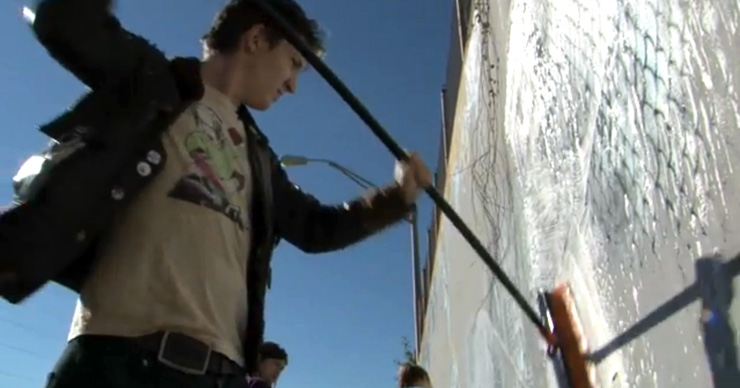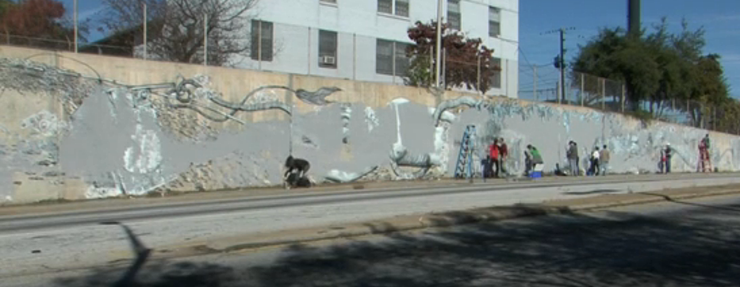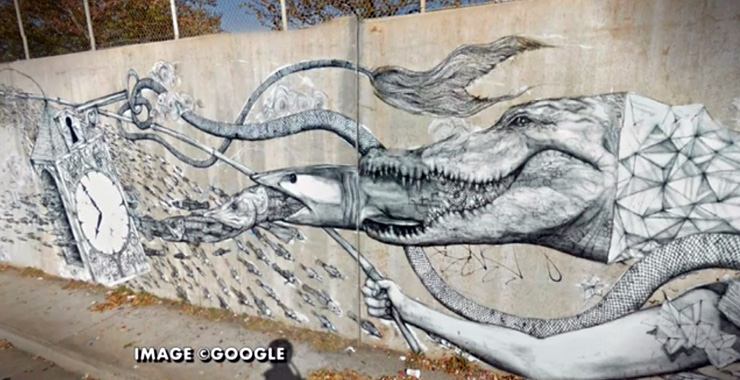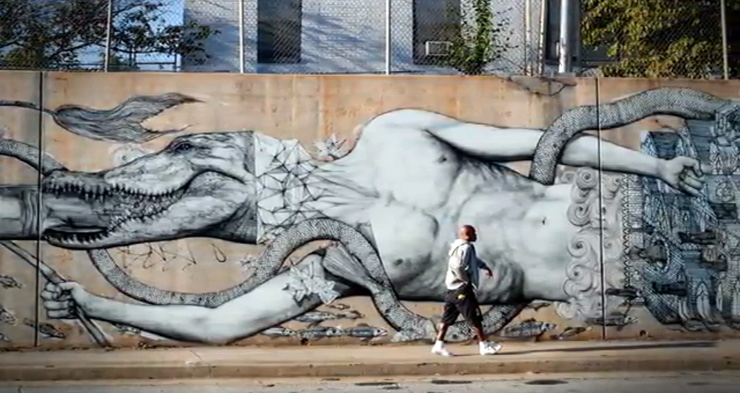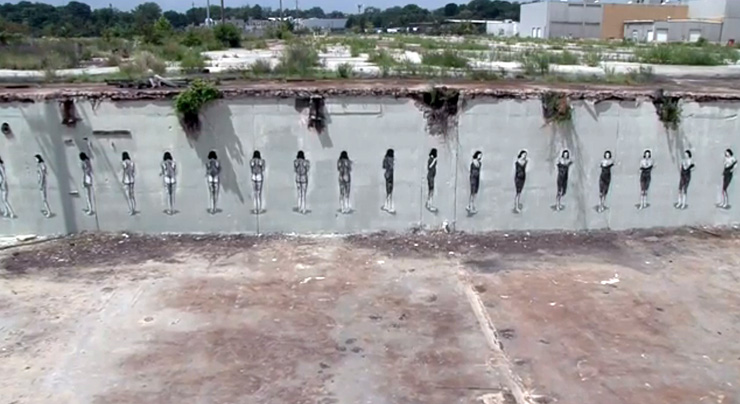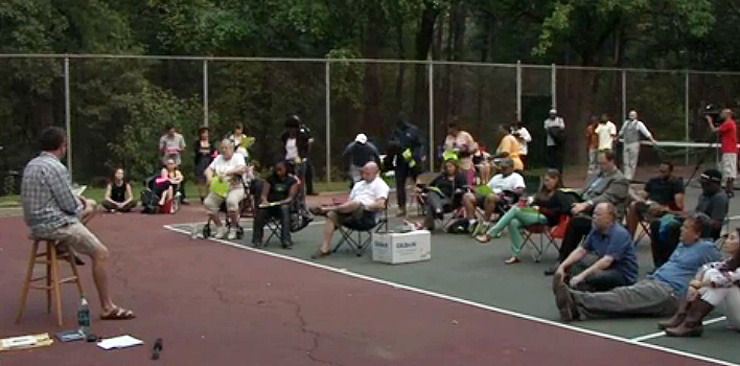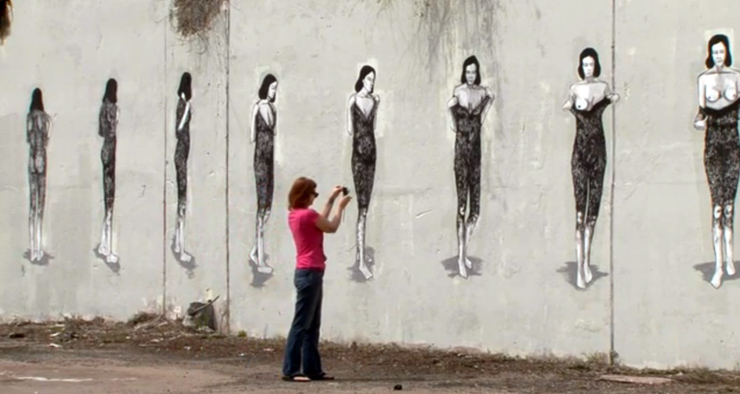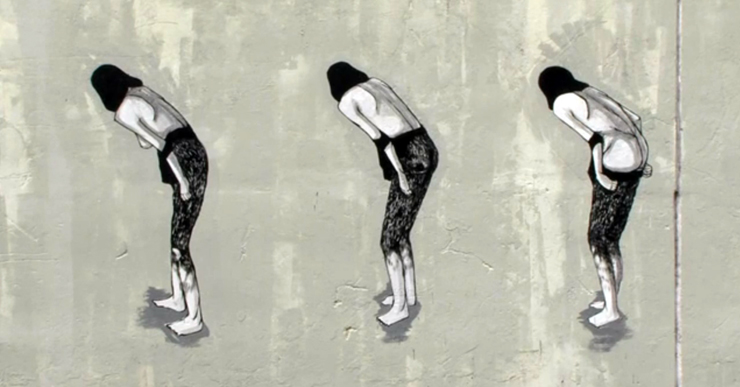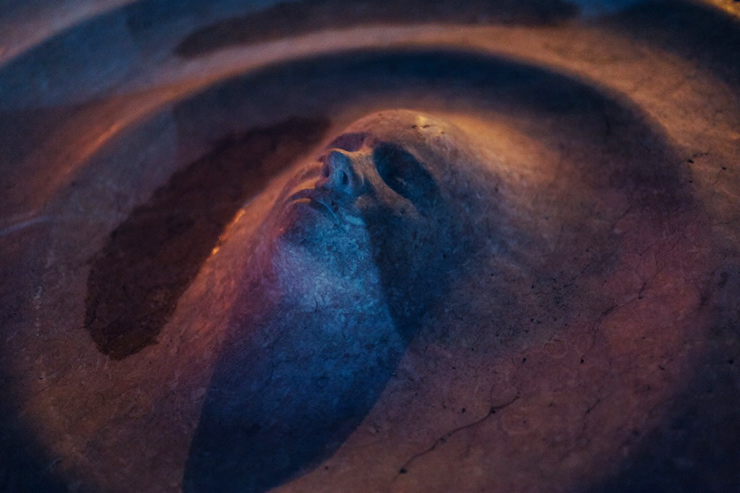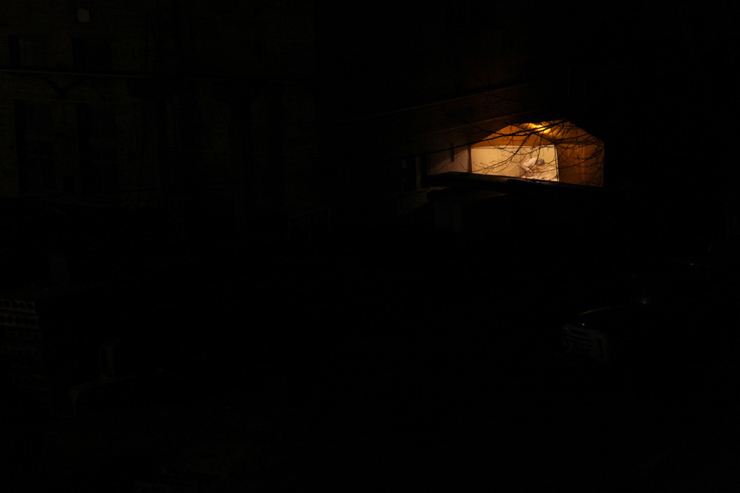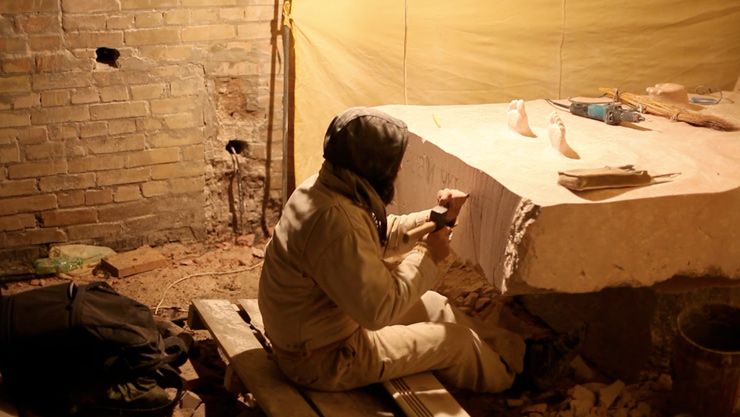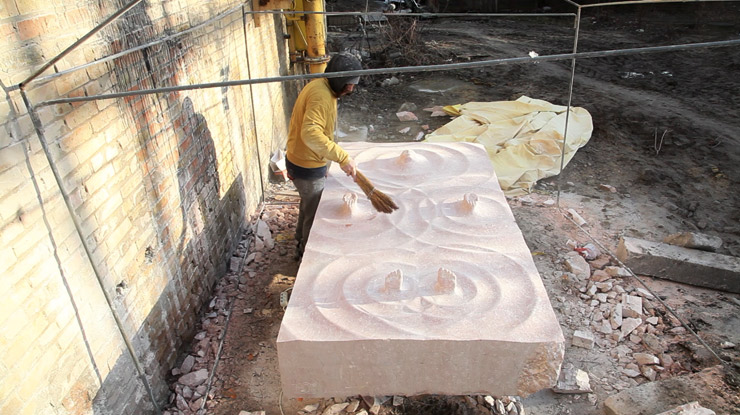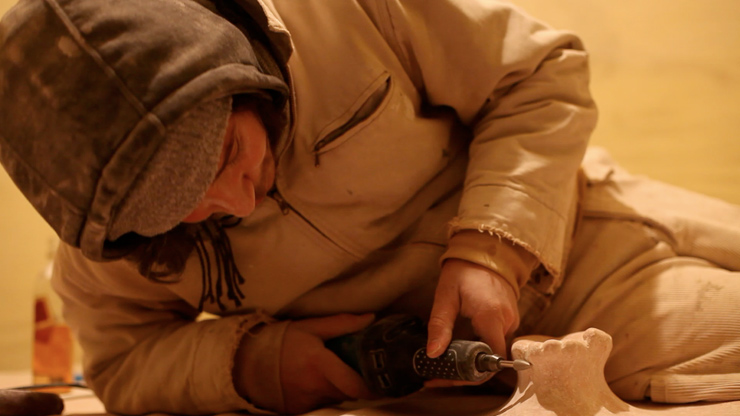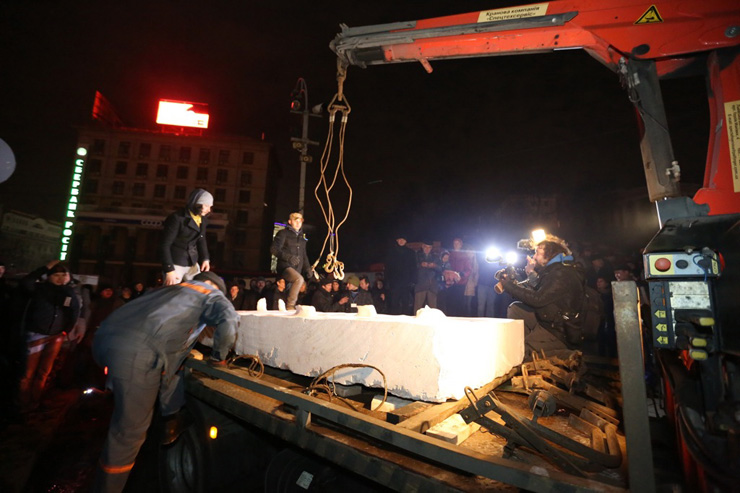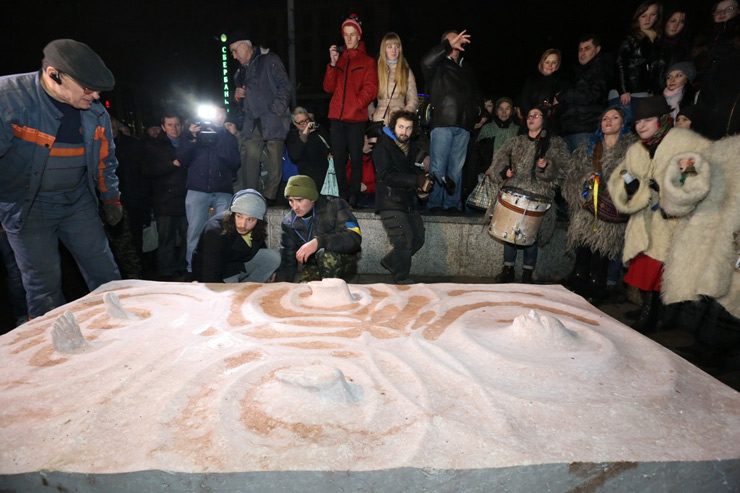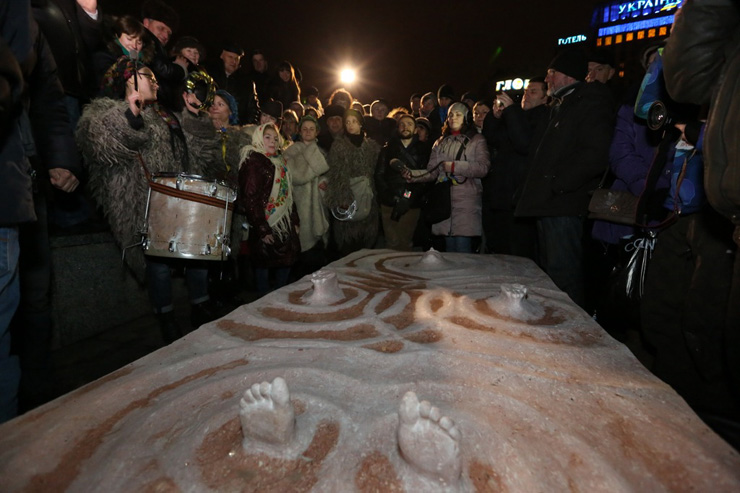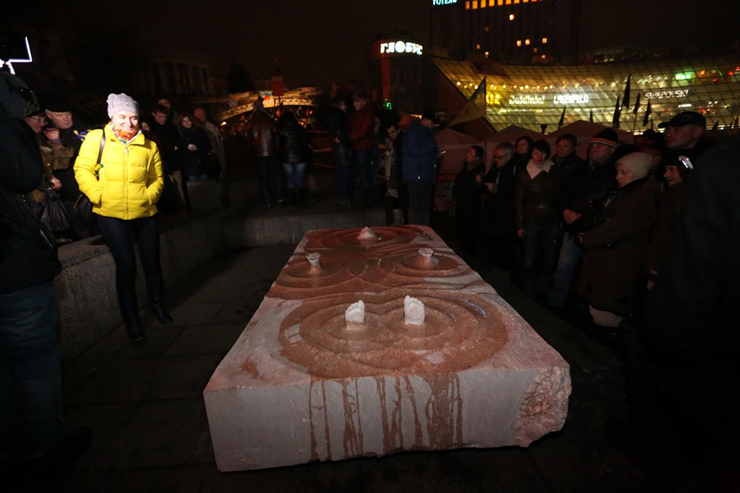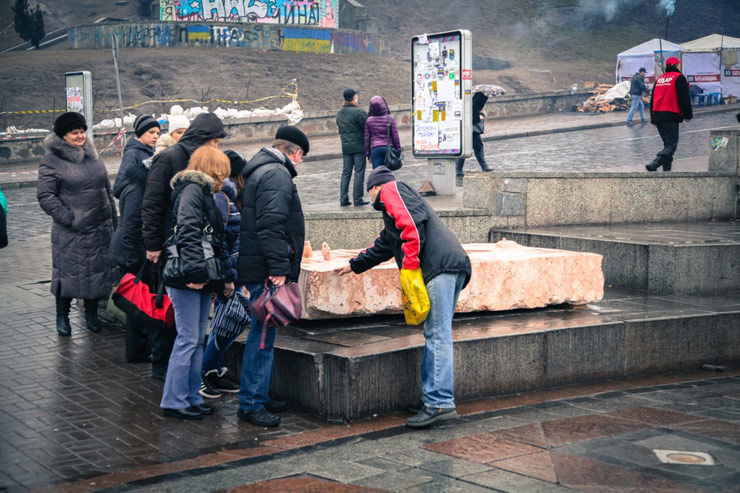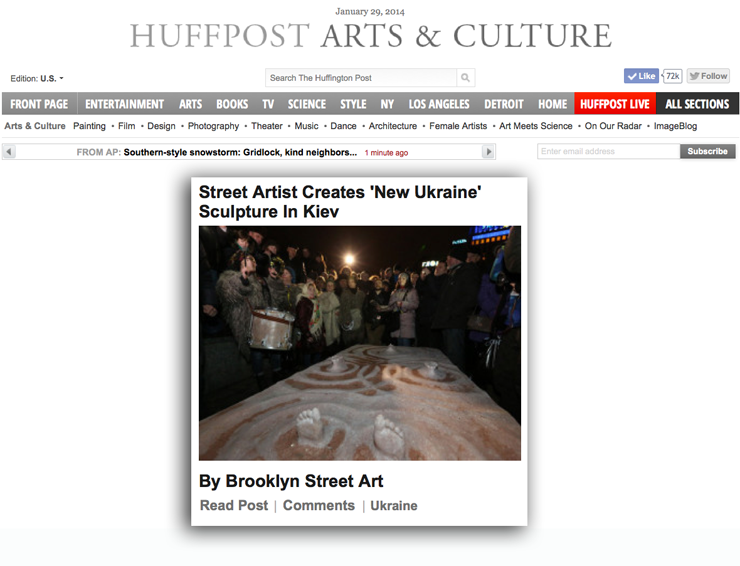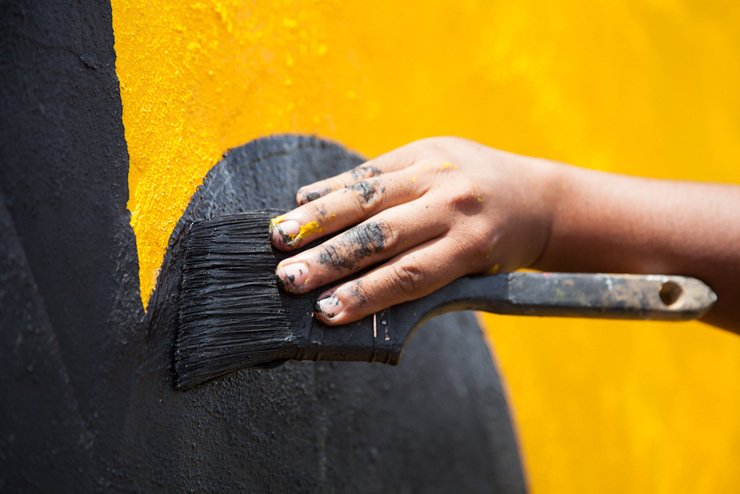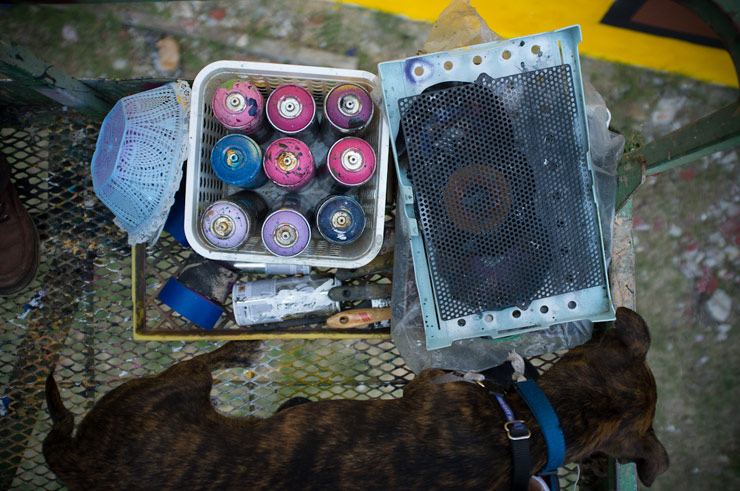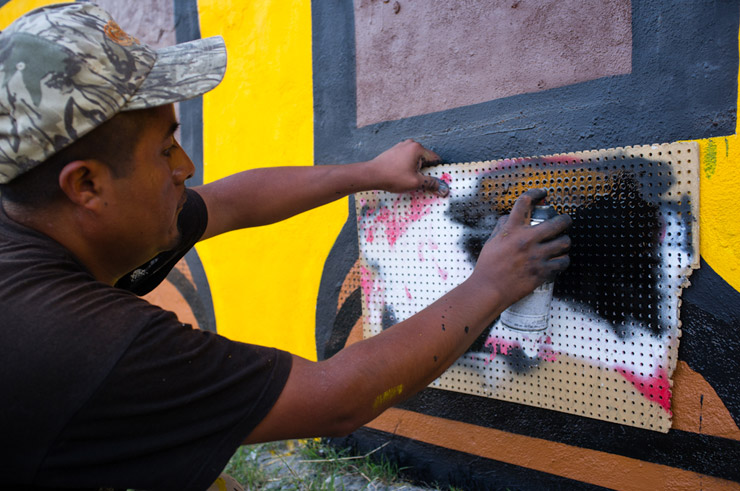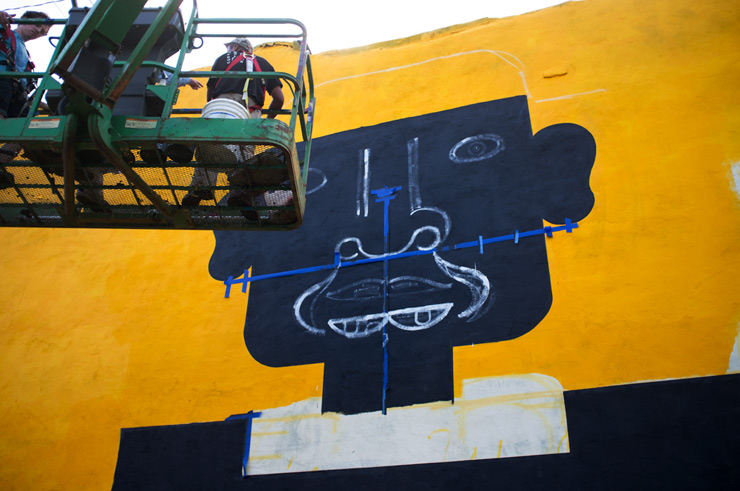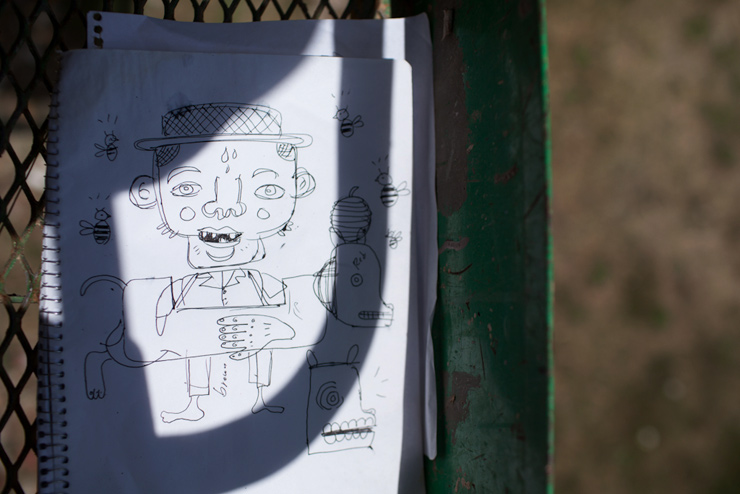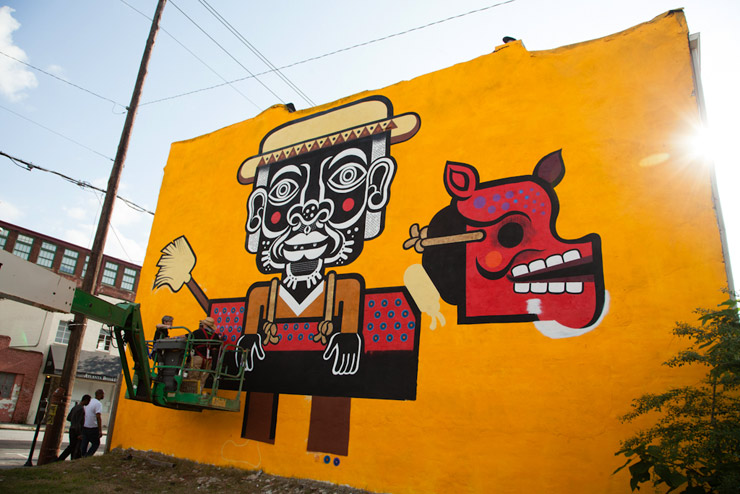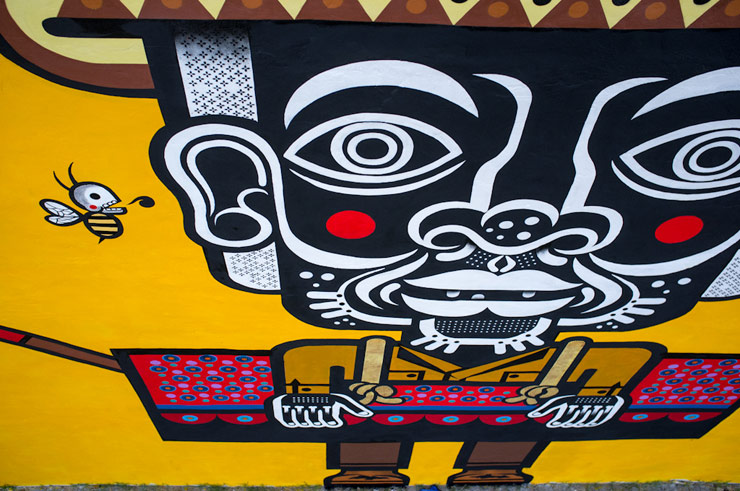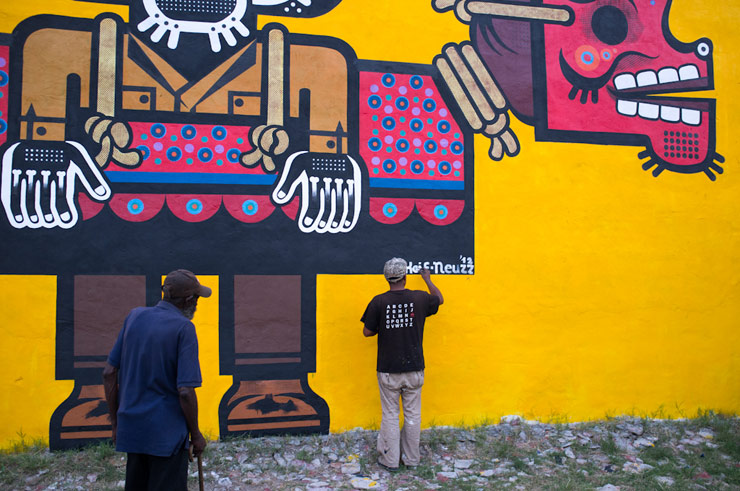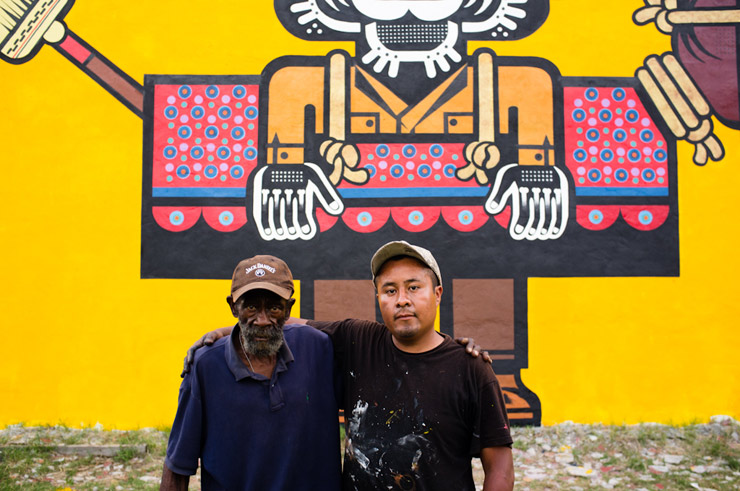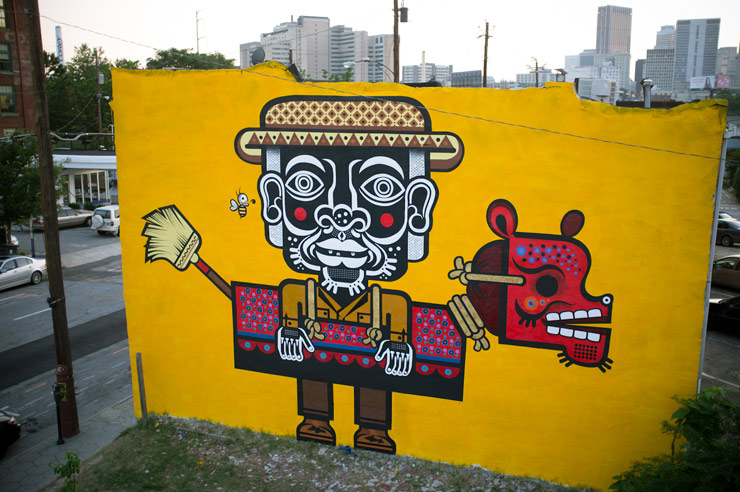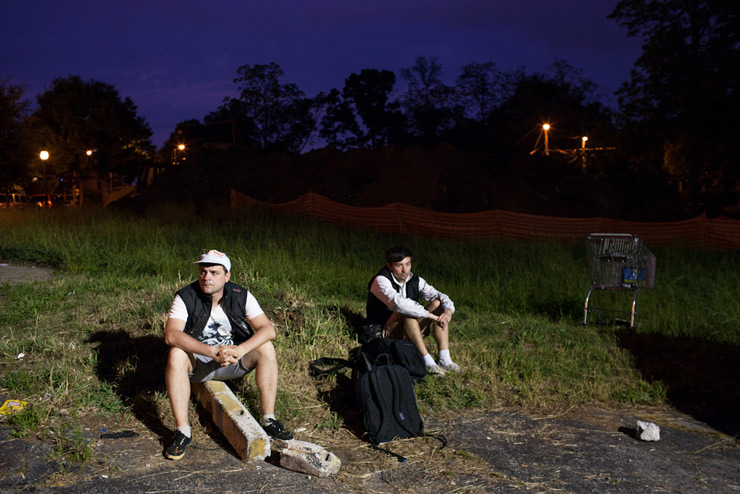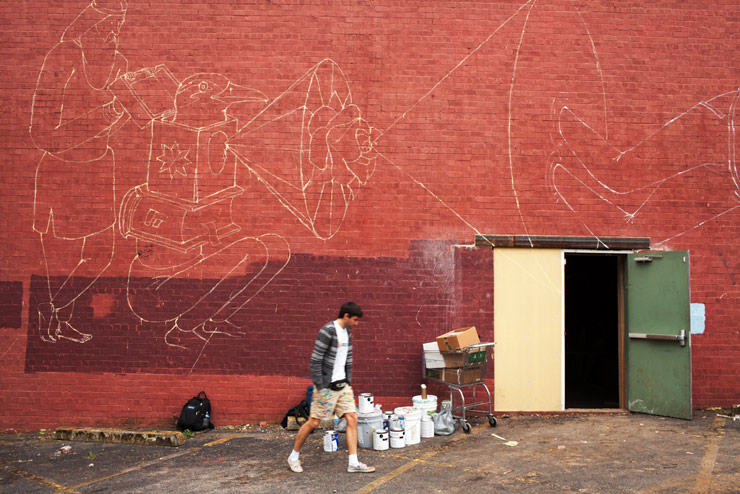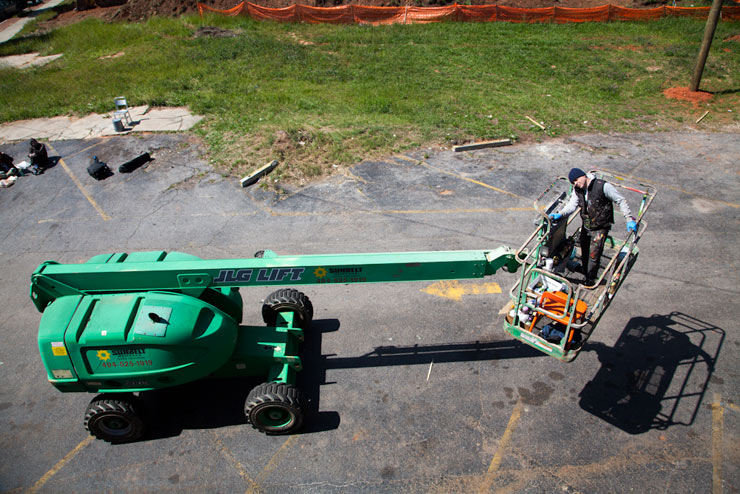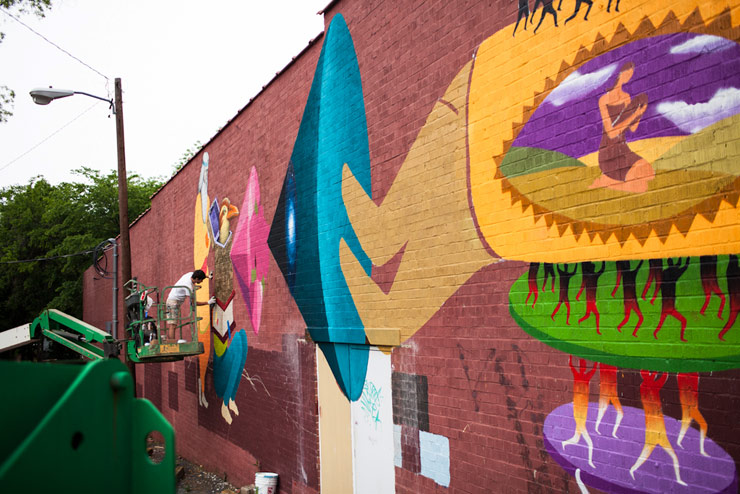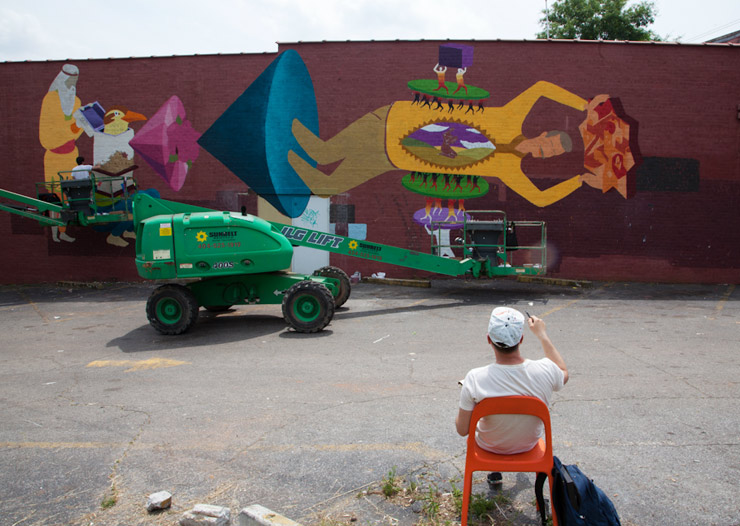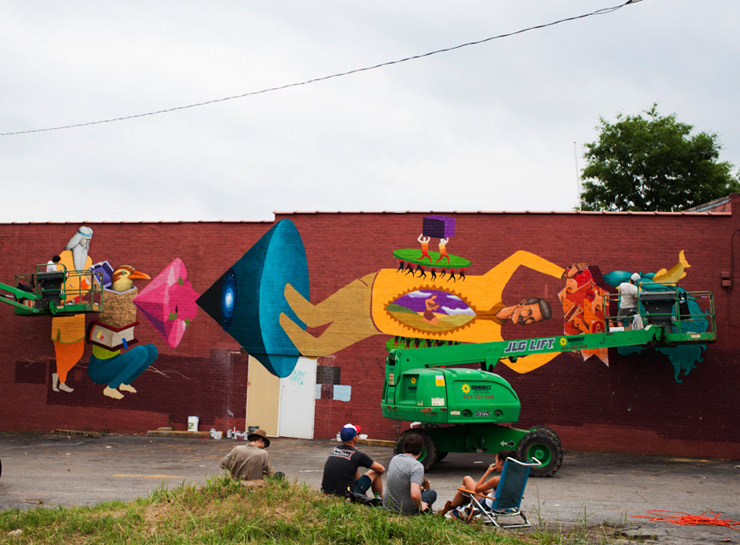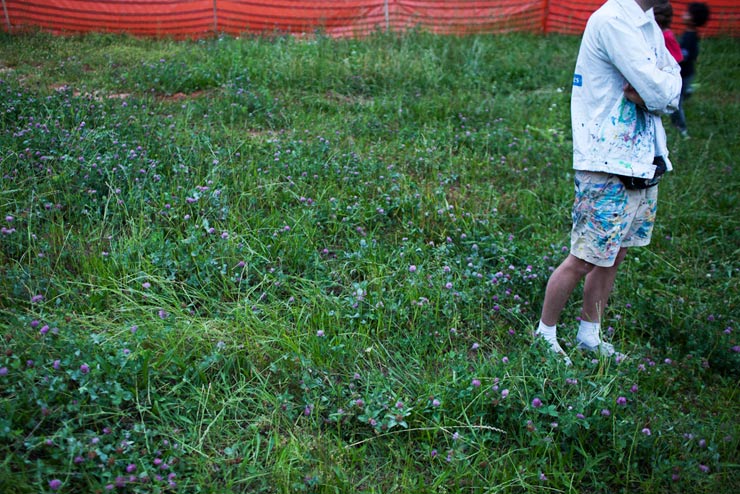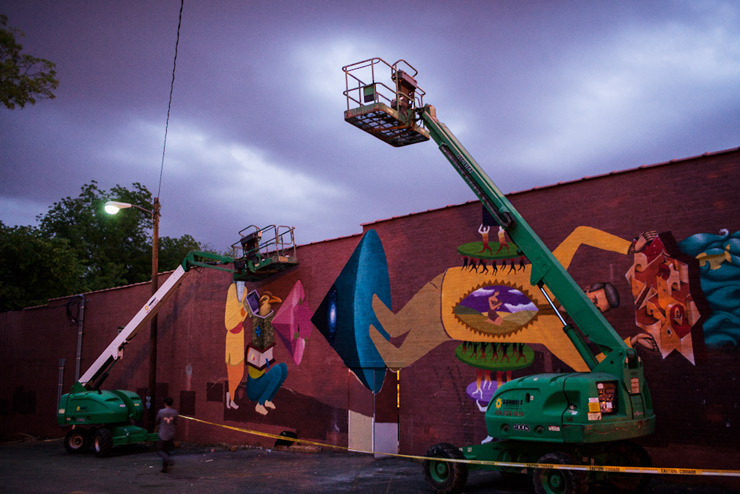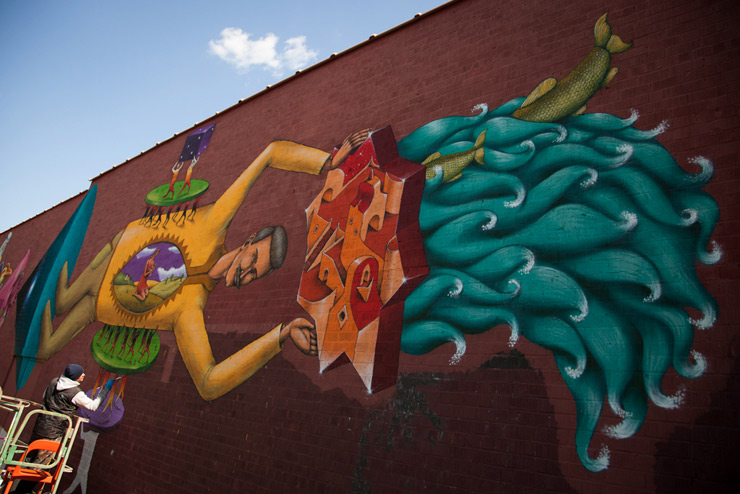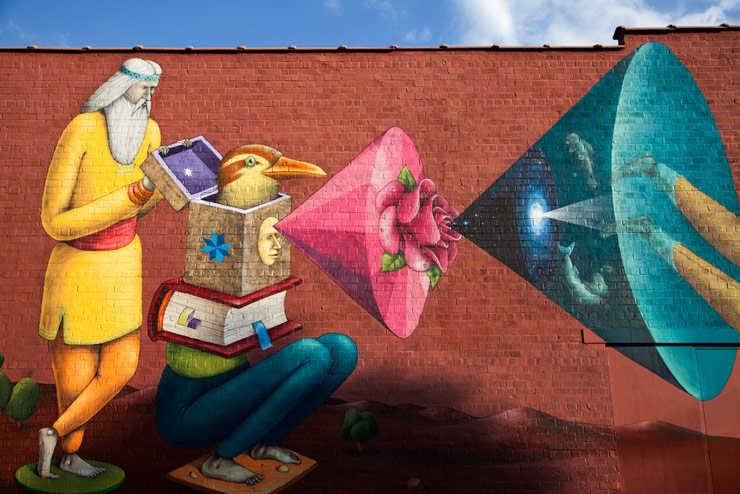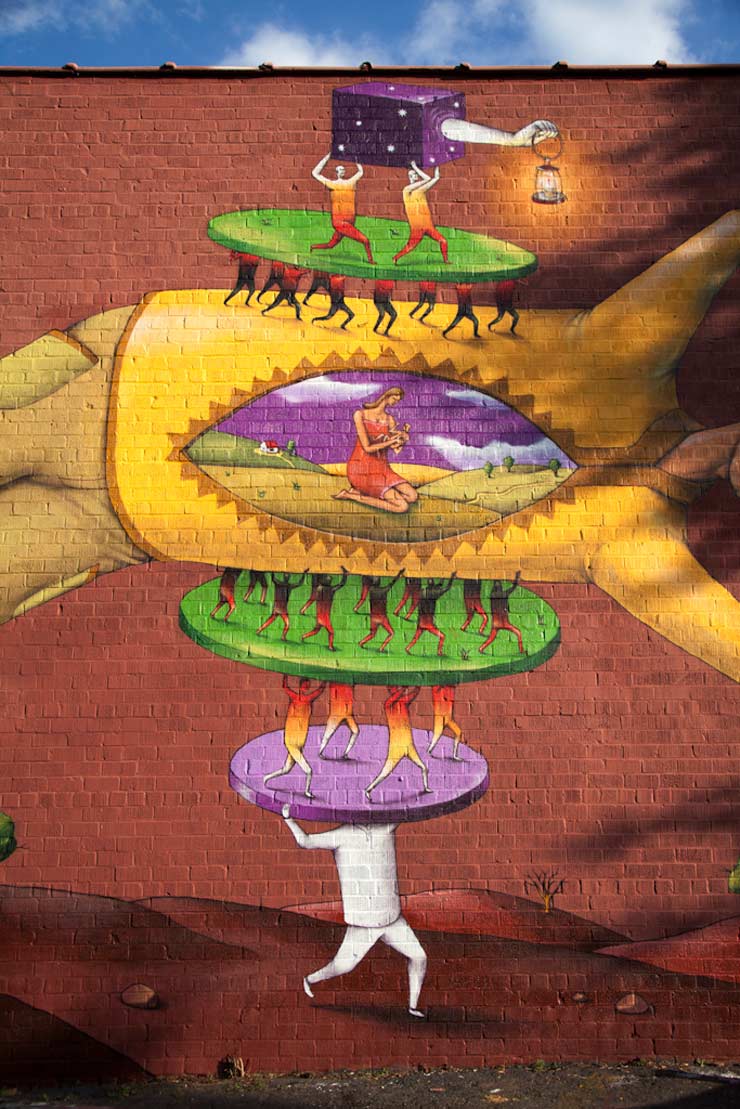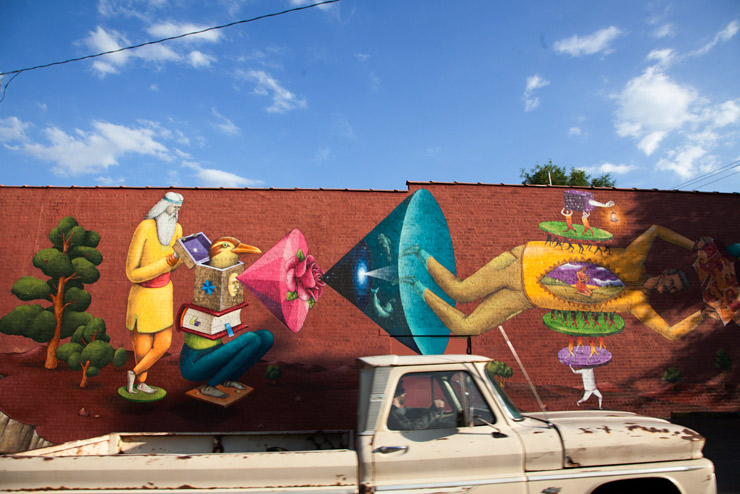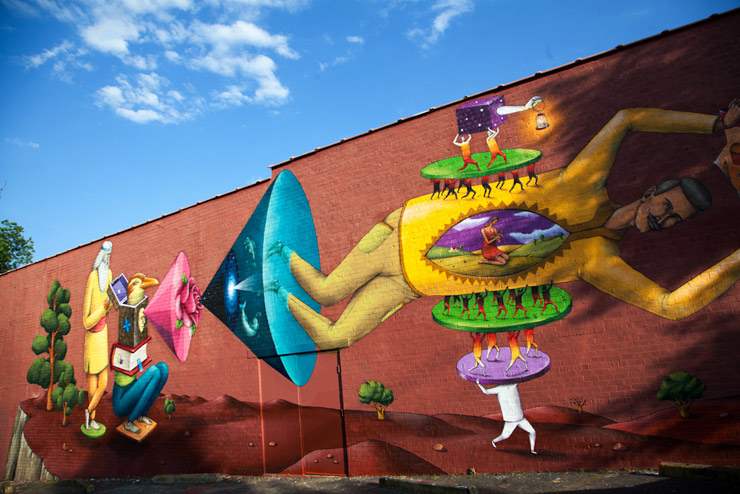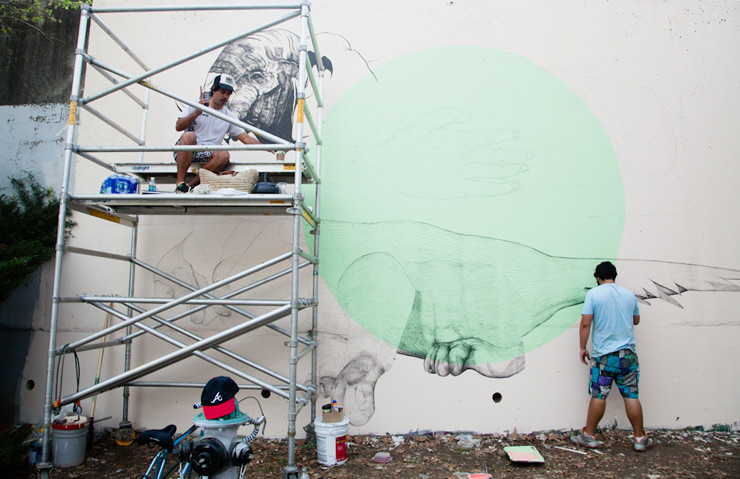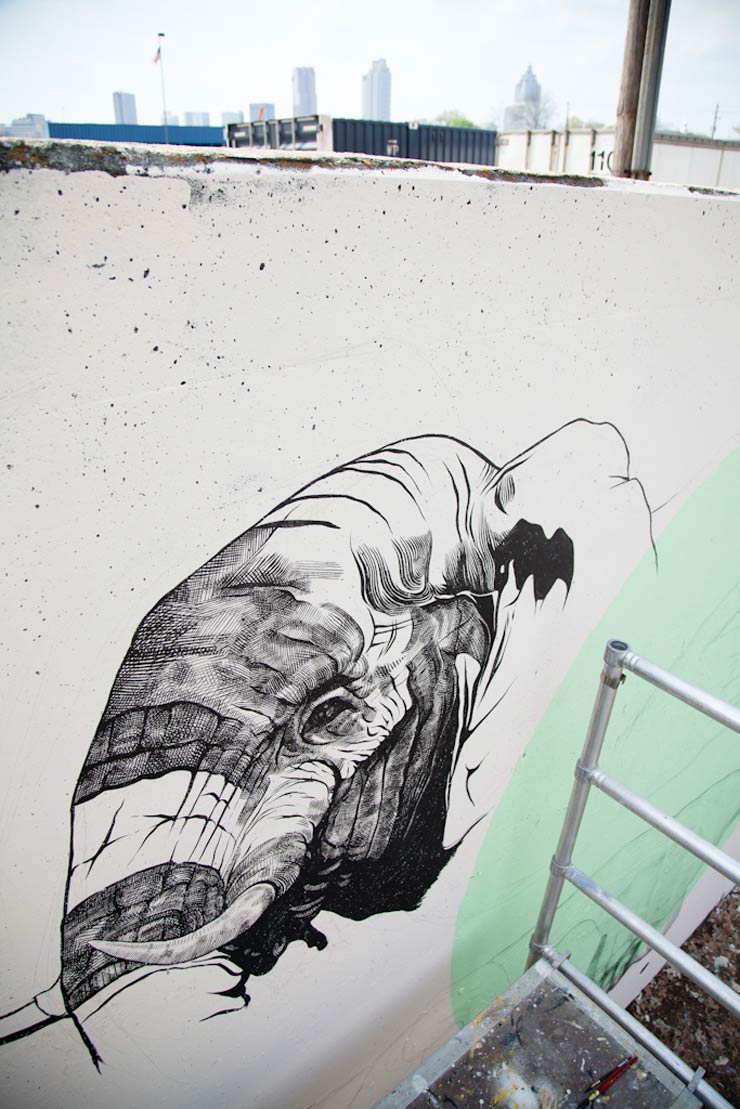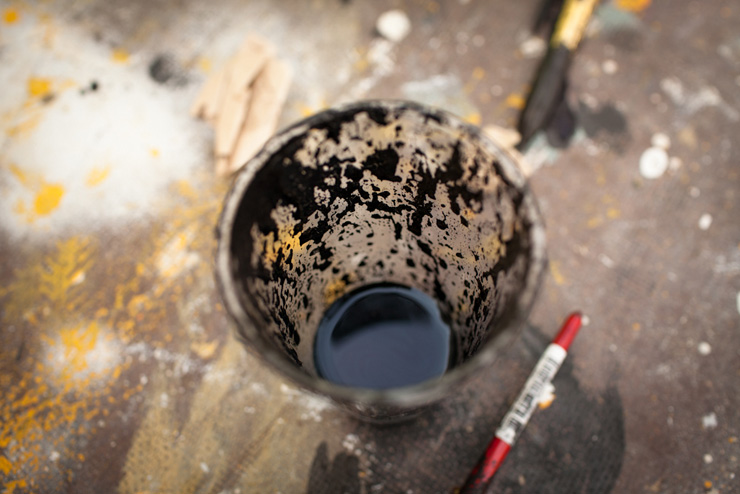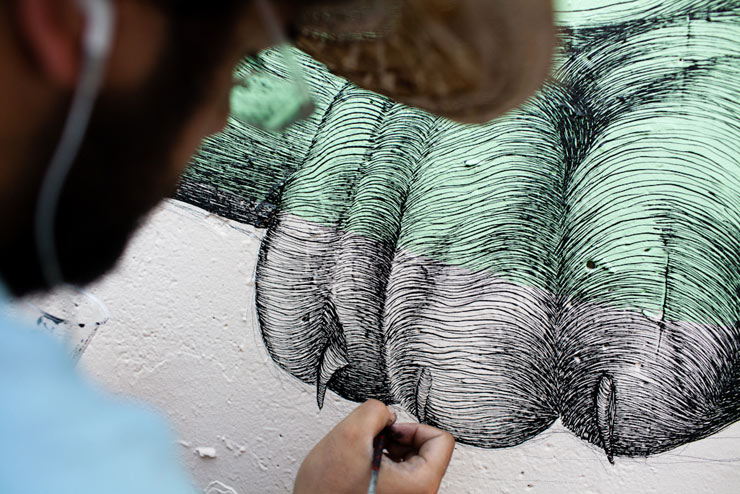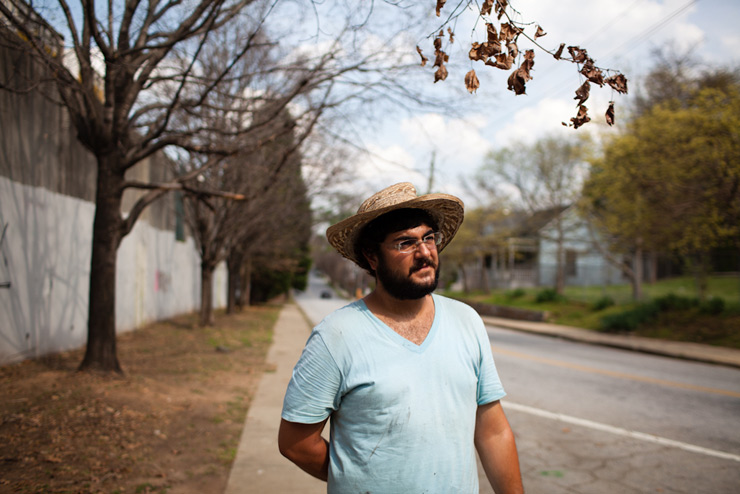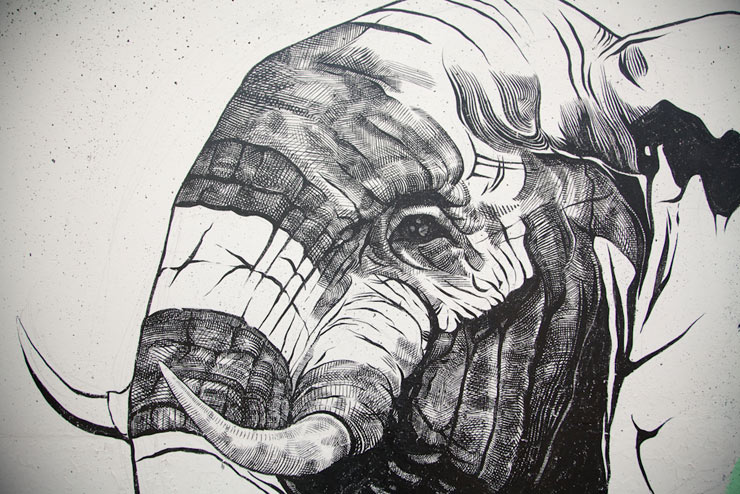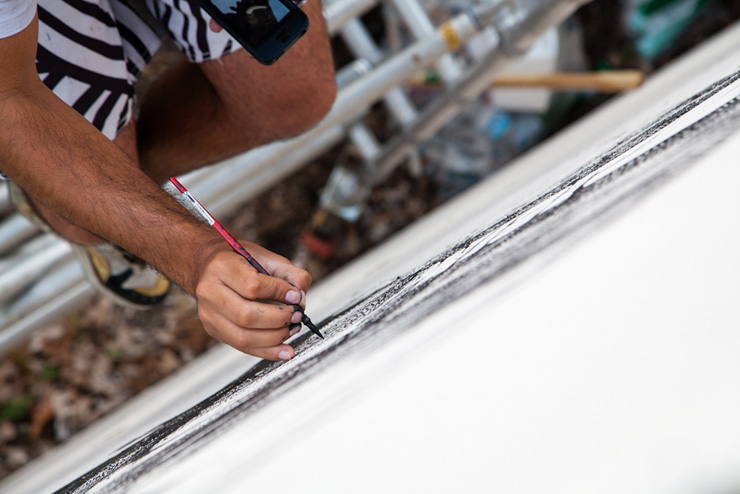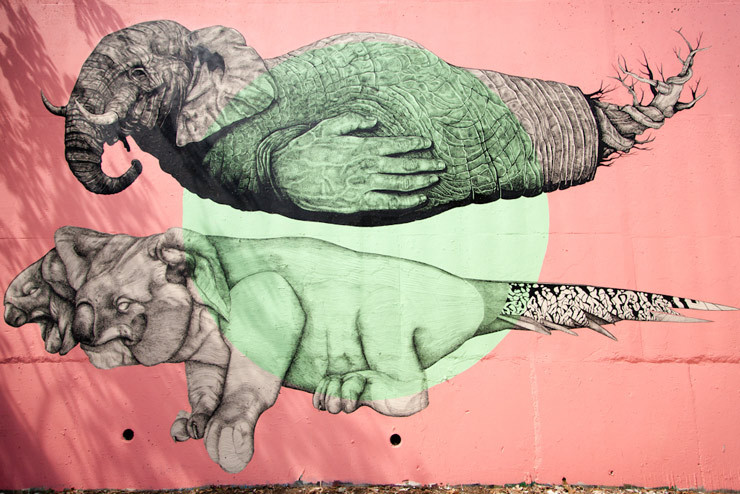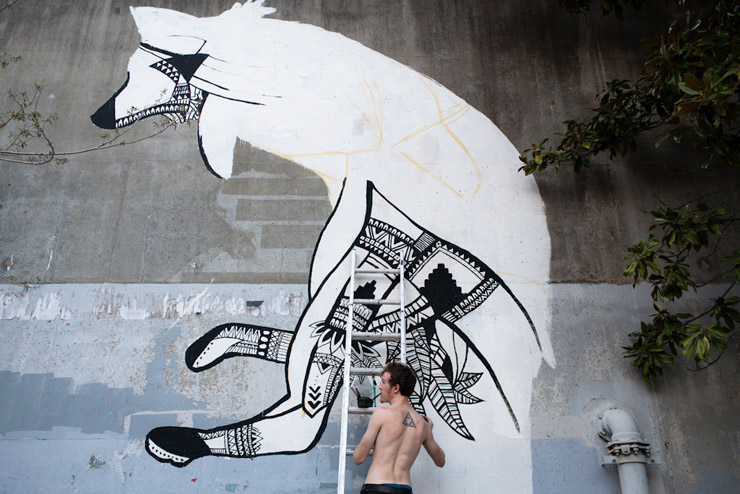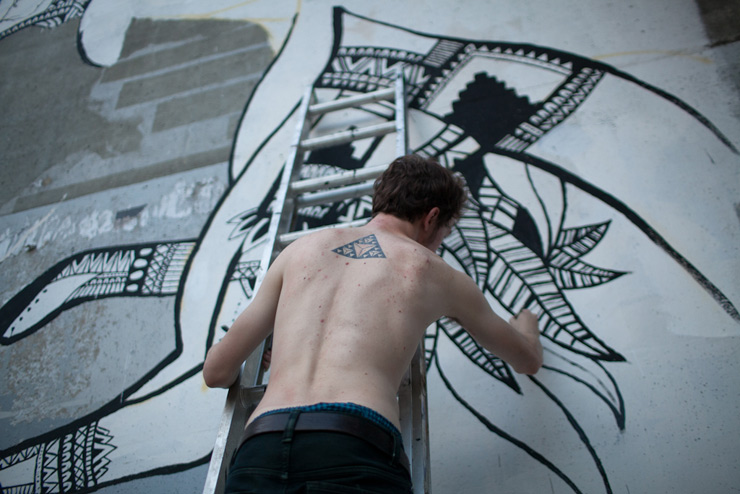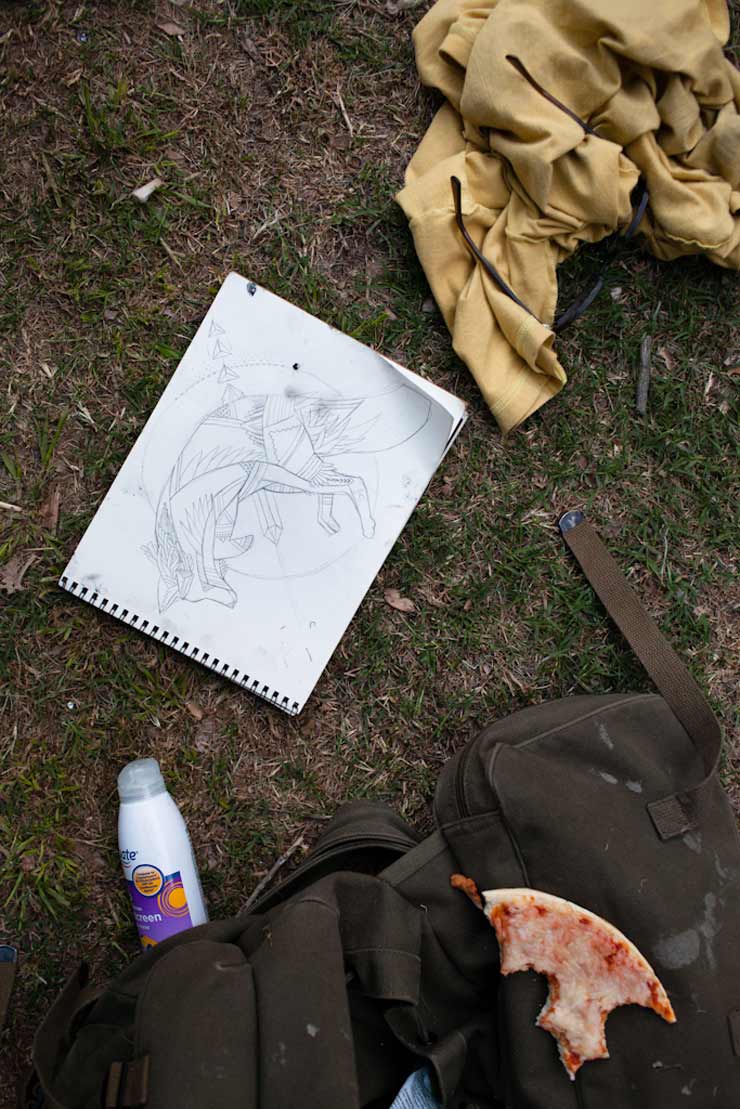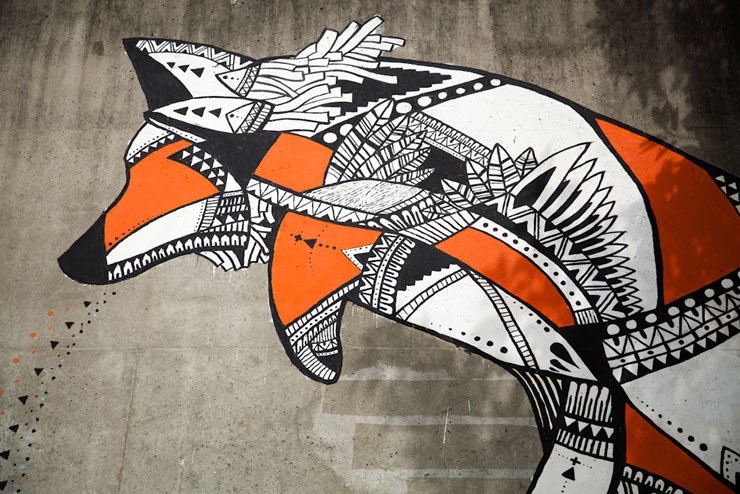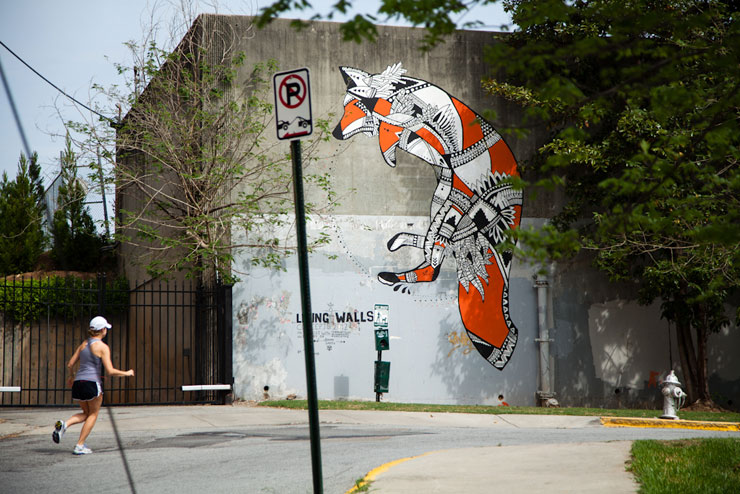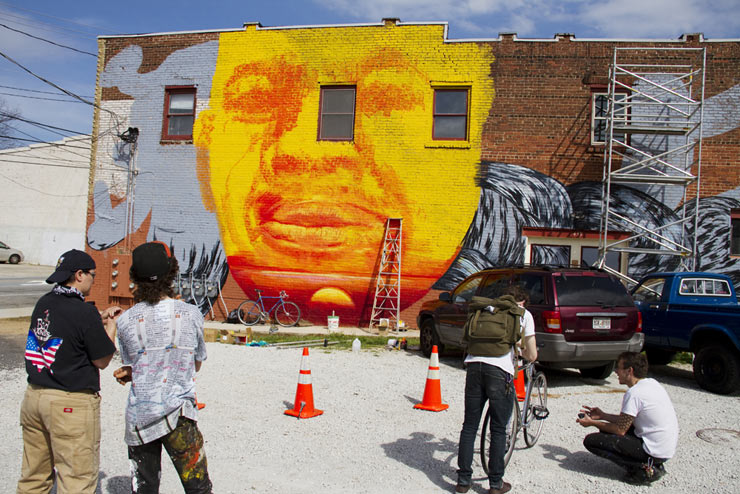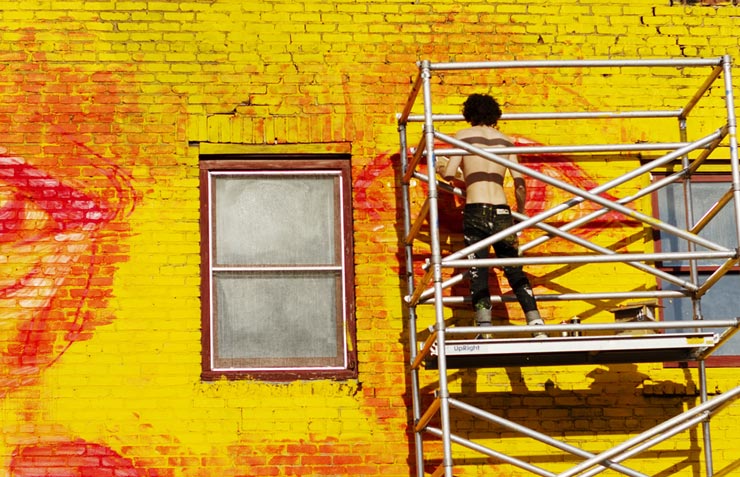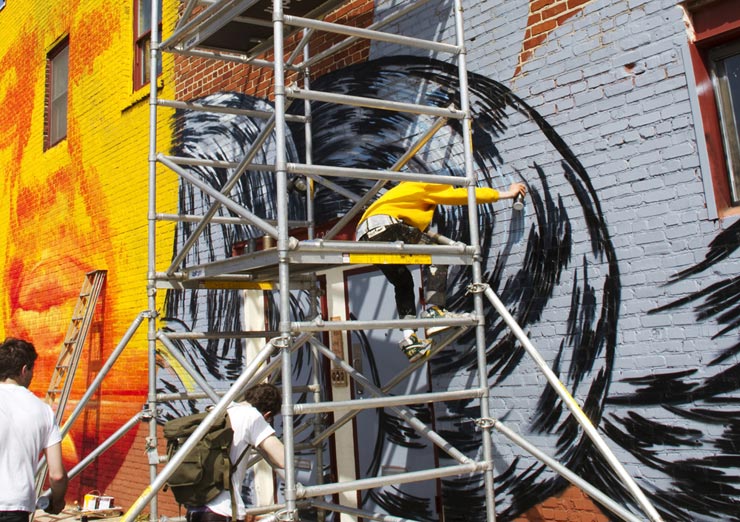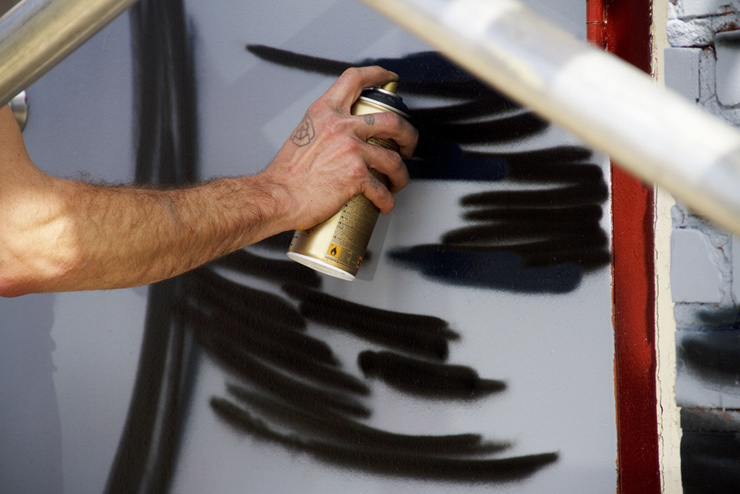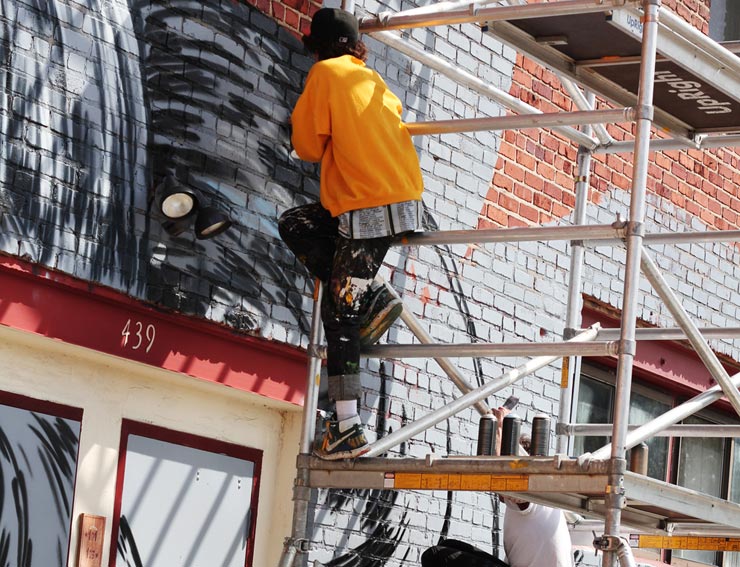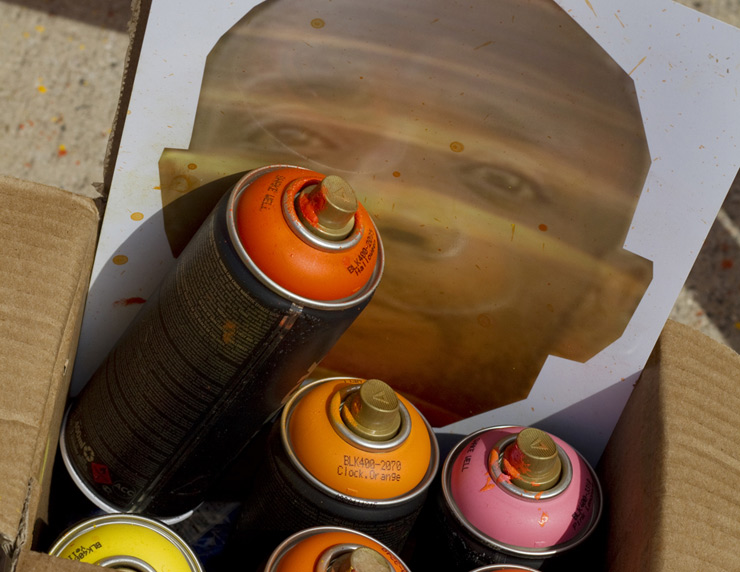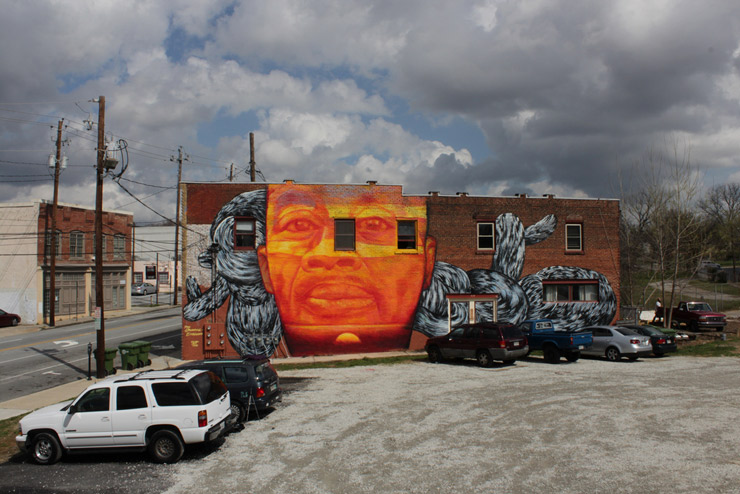A brigade of supporters washing the buff off of Roti’s mural in Atlanta (image courtesy and © of Trevor Keller and PBA from “A Tale of Two Murals”)
****************************************** By Alexandra ParrishIn the past five years, Atlanta has shaped up to be a veritable hub of the arts. Within this period, the city has witnessed a cultural renaissance thanks to a myriad of impassioned arts organizations and creative individuals. It should be mentioned that the largess of these initiatives came not from city officials, but rather propelled from the ground-up. Of those that have garnered international acclaim is Living Walls, the non-profit arts organization responsible for the installation of over one hundred murals across city limits.
As it stands today, Living Walls, among several other arts organizations and practicing artists are under attack.
A brigade of supporters washing the buff off of Roti’s mural in Atlanta (image courtesy and © of Trevor Keller and PBA from “A Tale of Two Murals”)
Let’s back track for a minute. Five years ago, Living Walls hosted the first street art conference in Atlanta, inviting over twenty artists from around the globe and their own backyard to complete a series of murals. The impetus behind the event was to garner discussion about public space in Atlanta that seemed overpowered by the freeways that divided neighborhoods, overwhelmed by billboards and generally ignored by the city. Although street art could not solve these problems, it got people talking. Due to the success of the first event, the once deemed “scrappy” organization continued, and murals began to display across the city as the annual conference came and went.
Along the way, Living Walls made a few mistakes. First, the organization was into the third year of operation when the city noted that despite approval by private property owners, every mural that Living Walls was responsible for were done so illegally. The city had in place an ordinance that required the approval of public art from three different city agencies in order to determine if the work was signage. By that time, Living Walls began to seek non-profit status, and in an effort to follow to the law at hand, they obliged to the arduous process of approval. From then on, Living Walls staff made the effort so that every mural was subjected to this procedure.
A detail of Roti’s mural in Atlanta (image © Google from “A Tale of Two Murals”)
Second, one mural completed during the 2012 edition sparked controversy. Hyuro, a renowned Spanish artist, completed a mural of a woman in a series of undress in the neighborhood of Chosewood Park. The nudity offended some people; some even deemed the work ‘pornographic.’ When the city was notified, the Office of Cultural Affairs (OCA) remarked that the work that they approved had, in fact, not made it on the wall: the original sketch by the artist depicted a number of folding chairs. The controversial work was ultimately buffed since it did not appropriately follow procedure.
The third mistake wasn’t exactly a mistake on paper. In 2012, on the tail end of the Hyuro controversy, the French artist Roti painted another expansive mural in the corridor of the Pittsburgh neighborhood. Living Walls, and the artist, followed procedure: the sketch (which made it on the wall, this time) was presented to three departments and approved. About a month after the mural was finished, controversy stirred again. Unfortunately, this is where the story begins.
I believe it’s important that I offer full disclosure: I am the former Communications Director of Living Walls. I started working with the organization back in 2011 as an intern, and continued until I eventually moved from Atlanta in 2013. I am also the partner of Roti, whom I met during his stay in Atlanta two years ago. I’ve witnessed these events unravel before me, and I’ve felt powerless as to how to react. Today I feel the inclination to respond to these events, because with many miles between me and Atlanta and everything that is about to happen, I finally understand.
Walking past Roti’s mural in Atlanta (image courtesy and © of Trevor Keller and PBA from “A Tale of Two Murals”)
We were in New York City when Roti and I heard the news: Camille Love, Executive Director of the OCA notified Monica Campana, Living Wall’s own Executive Director, that Roti’s mural had to be buffed. No explanation was given initially, but it would only take a matter of hours until we learned that several community members had objected to what they perceived as the murals “demonic” imagery. While Campana rightly justified that the city had approved the content and refused to buff the wall, about six men (including a former congressmen who I still can’t believe held office after watching this video) decided to do it for her – illegally. Despite their attempts, the water-based paint that haphazardly covered Roti’s mural stood no chance. In a matter of hours, over 100 people gathered with soap, water and sponges. Along with the help Department of Transportation, they managed to salvage the mural.
Roti and I were completely floored by the chain of events. I think for any street artist who travels the world painting murals understands that once they’ve done their work, it no longer belongs to them. It belongs to the people who have to see it every day, the communities of which it is in. I urged Roti to issue a statement about his work, but he refused to make any concessions. It didn’t belong to him anymore. We were just witnesses to the theater underway.
Hyuro’s mural in Atlanta (image courtesy and © of Trevor Keller and PBA from “A Tale of Two Murals”)
When I returned to Atlanta, the saga of Roti’s mural continued. Two council members from the area hosted a press conference to “discuss a resolution” with concerned parties. Conspicuously, Living Walls was not invited, nor anyone else who was in favor of the work. Word travelled fast and as soon as the cameras turned on, a crowd had gathered just opposite Roti’s mural. Those in front of the camera stood in their opposition to the mural, while those standing behind the camera maintained their support. The pundits spoke their grievances and the cameras were turned off. The hostility simmered to a boil once many from the community who believed in the work felt slighted, and seeking the opportunity to discuss their differences, were immediately shot down. I saw fingers pointed, voices raised and accusations slung. It was the most unfortunate event I have ever witnessed, and I will never forget.
Roti’s mural was buffed grey soon thereafter. Those council members who so vigorously opposed Roti’s mural assembled a committee that was determined to draft legislation so that an event like this would never happen again. In the spring of this year, they finally presented the legislation. Once the arts community caught wind of the initial proposal, valid issues were raised. Of the most paramount concern was that this ordinance would give city officials the right to make aesthetic decisions about private property, and anyone with knowledge of American civics can understand that this is a clear encroachment on first amendment rights. The ordinance, which was quickly ostracized by many Atlantans (not only in the arts), was shelved up until last week when the city council decided to take it up again to vote for approval.
A neighborhood meeting about the fate of Hyuro’s mural in Atlanta (image courtesy and © of Trevor Keller and PBA from “A Tale of Two Murals”)
This brings us where we are today, and where my long-winded explanation of this series of events will come to a close, but only after I offer my consideration of this entire situation. I understand the sentiment shared by those community members who did not approve of Hyuro’s and Roti’s murals is exacted because of just that: they were not notified, so therefore they weren’t given the chance to say yay or nay until the work was already up. I could get into specifics and blame the council members for this point (they represent these communities, and had approved of the work), but I’ll leave that aside. The point is, these people felt disenfranchised by the artwork. But can a hefty bureaucratic measure resolve this issue? Simple answer: no.
That brings me to another concern. The legislation requires a lot of work on behalf of the artist and private property owner. I’ll give the city some credit where it’s due that they are trying to “streamline” the process by funneling all the paperwork through one office, but the paperwork in itself still requires too much red tape over the freedom of expression. I would even dare to suggest that it would deter individuals (or smaller organizations than Living Walls) from making so much as an attempt to follow this draconian procedure. In other words: this legislation stifles creativity.
Hyuro’s mural in Atlanta (image courtesy and © of Trevor Keller and PBA from “A Tale of Two Murals”)
This civic creativity is what has put Atlanta on the map in terms of the arts and culture. It came from the porches, bars and backyards. These informal networks, which are made on a daily basis, built the cultural capital of Atlanta. And it is precisely because they had the freedom to do so. That is why I will go so far to claim that this legislation is an attack on the arts in Atlanta, because if it is passed, it will eventually alter this practice. If murals are accountable to time-consuming subjugation, so is the imagination of these artists.
I may no longer live in Atlanta, but the city is still part of my identity. I’ve traveled to different places around the world and have had the pleasure of meeting many people who knew of Atlanta, not only because it hosted the Olympics back in 1996, but also because of it’s flourishing arts scene. If the city takes this step to restrict artwork, they will undoubtedly place a constraint on the creative industry that has followed. Those “scrappy” organizations like Living Walls may fall short to the city’s demands, and others may never even surface.
For the sake of creativity, let it be.
Hyuro’s mural in Atlanta (image courtesy and © of Trevor Keller and PBA from “A Tale of Two Murals”)
An addendum:
*After a public meeting this week with the committee spearheading the legislation, councilmember Joyce Shepard has decided to take more time to review the proposed ordinance. Additionally, she suggested that perhaps arts and legal experts could offer further consultation. While I would like to dictate some optimism on behalf of this news, I find it politics at best. When initial proposal faced criticism from arts organizations and artists alike, city council attempted to thwart constructive input by rescheduling a public meeting nearly five times. This news echoes the habitual avoidance demonstrated by city council since the onset of the proposed legislature.
However, let us hope that the ostracism of the arts community by the city council in drafting this public art ordinance is subject for reversal. Perhaps, this time around city council will review these points made above, which sound loudly among all artists in Atlanta.
<<><>><>><><>><><><><><><<<<<<<>>>>><<<>>
To see the documentary “A Tale of Two Murals” in its entirety, please go to http://www.pba.org/programming/tale-two-murals/
Our thanks to Trevor Keller for the screenshots from the film used to illustrate Ms. Parrish’s essay.
<<>>><><<>BSA<<>>><<<>><><BSA<<>>><><<>BSA<<>>><<<>><><BSA Please note: All content including images and text are © BrooklynStreetArt.com, unless otherwise noted. We like sharing BSA content for non-commercial purposes as long as you credit the photographer(s) and BSA, include a link to the original article URL and do not remove the photographer’s name from the .jpg file. Otherwise, please refrain from re-posting. Thanks! <<>>><><<>BSA<<>>><<<>><><BSA<<>>><><<>BSA<<>>><<<>><><BSA
 BROOKLYN STREET ART LOVES YOU MORE EVERY DAY
BROOKLYN STREET ART LOVES YOU MORE EVERY DAY